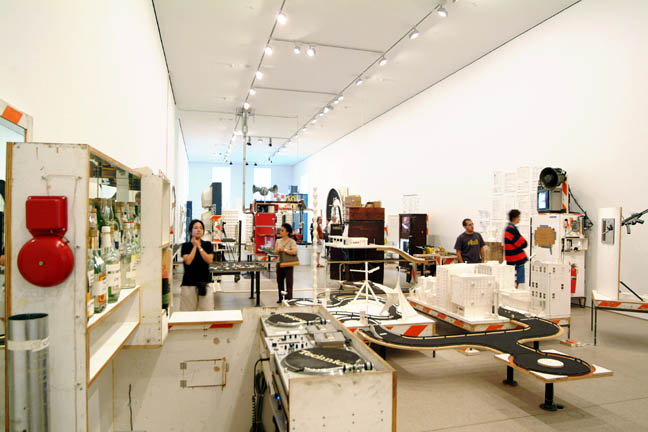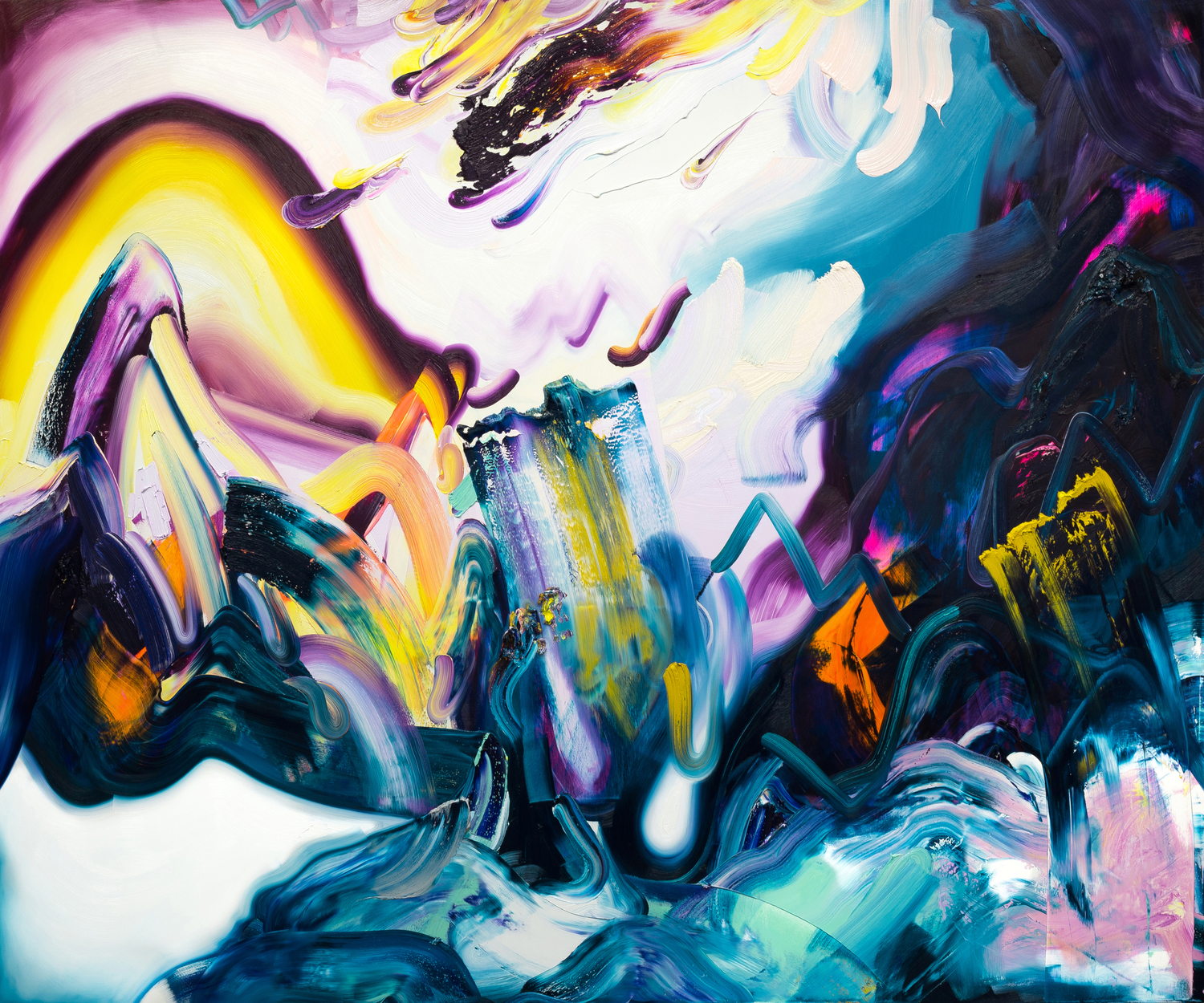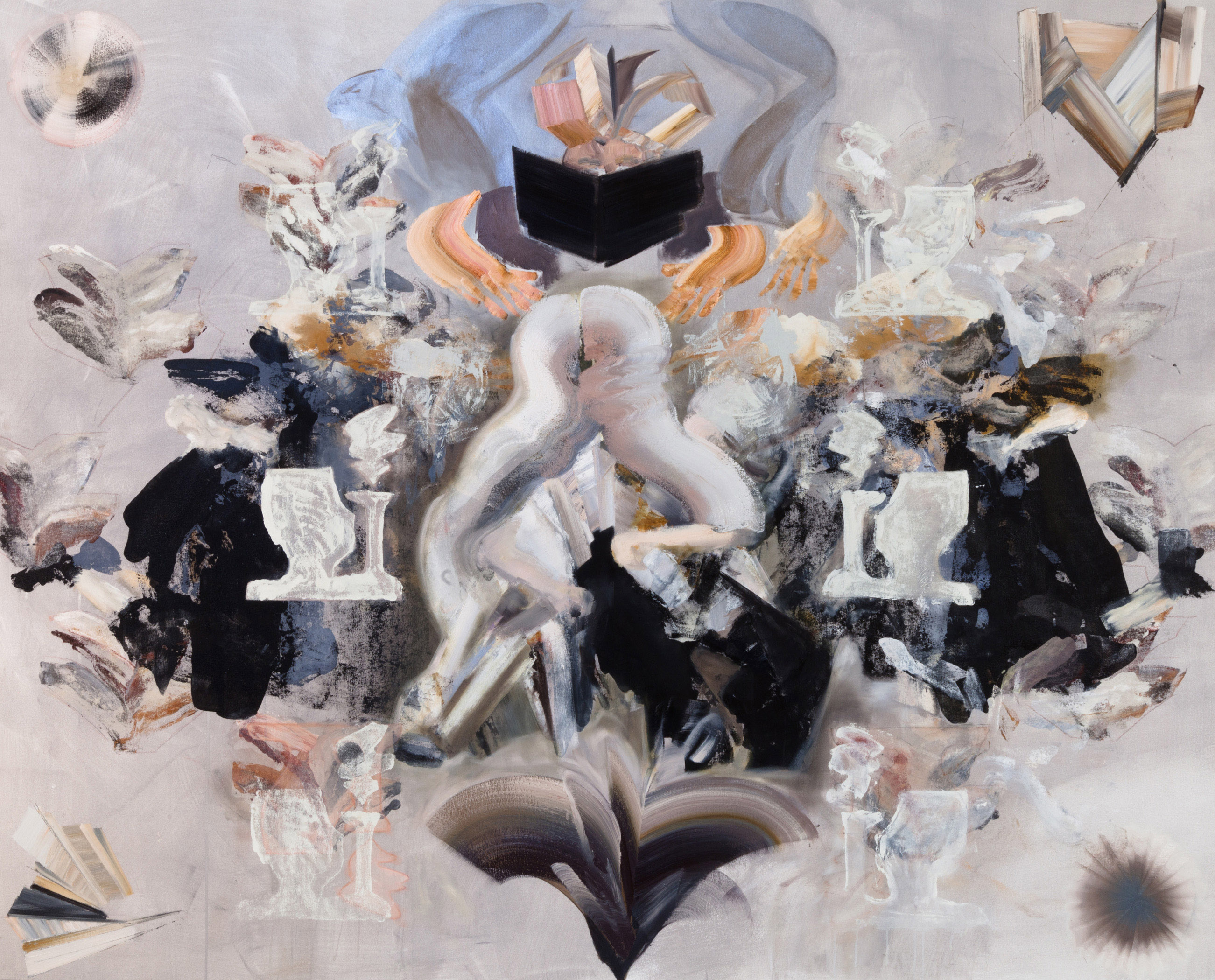
By Randy Gladman
It’s a Tuesday night in Lower Manhattan. Race night. I’m at Tom Sachs’ production facility on Hester Street, three blocks from his studio, two blocks from his home. Chinatown. This giant factory is on the third floor of an ancient building that once housed the New York City Police Department’s mounted division. There’s even a horse elevator, which will soon be used to transport the components of Nutsy’s, Sachs’s newest installation and most ambitious project to date, to the new Bohen Foundation gallery in Manhattan’s Meatpacking district for the Winter 2002 exhibition. Commensurate with the physical scale of Tim Hawkinson’s museum-swallowing Organ (1999), and the swaggeringly cocksure charm of a David Bowie live performance, this gargantuan Pop race track made of foam core, steel, video monitors, Sharpie pen ink, wooden police barricades, glue, and asphalt connects together a dizzying sculptural universe.
Race night at Nutsy’s, like every Tuesday for the past five weeks, starts at 9:00pm and continues for an hour of somewhat childish craziness. These weekly parties are ‘user-testing’ nights where Sachs, his friends and his production team race on the track to work out the kinks in a complex game system. When Nutsy’s is eventually installed as a whole, visitors will be welcome to interact with the work; if they bring their own 1/25th scale Kyocera Mini-Z remote controlled race car, they will be able to run it on the track. Tonight is Sachs’ final chance to figure out what works and what doesn’t before the entire installation is shipped uptown.
One of Sachs’ friends spins Hip-Hop music from behind The Booth, a functioning sculpture that marries an alcohol bar with DJ turntables. An Eminem tune floods the studio, the oppressively powerful decibels pouring from another functional sculpture, this one a 10,000 watt ghetto blaster called The System. Employees of Allied Cultural Prosthetics, the production company Sachs formed to fabricate his works, buzz about the studio, making crafty, last minute repairs to broken foam core ramps and Mini-Z race cars. Instead of traditional sculptors’ tools, they wield glue guns. As they wander around the studio, the other ten guests present tonight seem as amazed and pleasantly bewildered as I am by the incredible scale and awkward charm of the project.
My first impression took me back to a toy train model-village a childhood friend built in his basement with his father years ago. The working train track itself was simply an excuse to craftily build a miniaturized village, complete with farm land, rolling hills, Main Street, and country houses, all made of paper-maché, plastic and paint. That was an attempt to realistically replicate the physical aspects of a country town, a folksy landscape sculpture derived from traditional craft practice.
Nutsy’s, however, replicates identity rather than landscape and creates a physical space where the intrinsic aspects of modern popular culture are condensed and turned into iconic objects. Instead of pleasant church steeples and colonial town halls, Sachs litters his world with modernist architecture, urban ghettos, aggressive contemporary music, mini-bars, and gas stations. Nutsy’s – the culmination of Sachs’ studio activity over the past two years – is a conceptual rendering of the current state of American life, mimicking the prominence of fast food, drug dealing and consuming, security surveillance, governmentally controlled alcohol distribution, Hip-Hop music, car-culture and drive through architecture.
Sachs is, more than ever, a little kid with big boy financing. Though the installation is rooted in male youth desires, there is no doubting the huge resources that have gone into this ambitious project. Since 1995 when he had his first solo show in New York at the Morris Healy Gallery, his work has consistently sold well and garnered a plethora of (positive and negative) critical attention. His Haute Bricolage show at Mary Boone in 1999 was by all accounts a financial boon, and exhibitions of his work are usually accompanied by juicy scandals of some kind, whether it is the night Boone spent in jail as a result of his show in her gallery or the outrage that bubbled from his Prada Death Camp sculpture shown in a recent Jewish Museum exhibition. His works regularly appear at the major contemporary art auctions in New York, often sporting sales estimates with five digits or more.
All of this has played into the conception of Nutsy’s by lending Sachs an incredible sense of confidence and the huge credit line required to pull off the project. The centre piece of the exhibition is Unité de Habitation, an exact 1/25th scale replica of Le Courbusier’s building of the same name in Marseille (the 1/25th scale ratio is derived from the scale of the Mini-Z cars and the consistency of the scale enables the trompe l’oeille effect of the entire installation). Made from foam core and hot glue-gun glue, this 9 x 18 x 2.5 foot sculpture took a team of 14 assistants 10 weeks full-time to construct and epitomizes the Sachs signature style of high-fidelity to detail while simultaneously making a conscious effort to maintain the low-fidelity touch of the creator’s hand; glue drips and finger prints stain the surface of the building, while crooked and obviously hand-made lattice work replicate in sloppy yet exacting detail the surface facades of the real building. Incredibly labor intensive, this piece is but one of a number of elements of Nutsy’s obviously requiring huge investments of capital, most of which came via a commission from the Bohen Foundation.
Not having a remote controlled car of my own, I try to contain my jealousy as I watch Sachs and four of his assistants race each other through the sculptural system. Though they are all grown men in their thirties, their behavior over the next half-hour resembles nothing as much as a group of teenage boys playing Playstation 2.
Rules of the race are byzantine at best. Two cars race on the track at once and must complete various activities along the route before finishing as quickly as possible. One of numerous obstacles occurs near the beginning where the driver must navigate his Mini-Z cars to the Bong Hit Station. Similar to a pit stop, this element of the race track includes homemade water bongs (for smoking pot) and lighters embedded directly into the race track. Once reaching this location, the driver must pick up his race car, attach a $5 bill to its roof using an elastic band, and then drive over to The Booth where the DJ, on his own sweet time, picks up the car and exchanges the $5 bill for a small amount of ‘wizard weed’ (a legal THC-free herb that, when lit and inhaled, smells and tastes like marijuana but has no narcotic effect). The driver must then navigate the car back to the Bong Hit Station, inhale a hit of the wizard weed from a bong and exhale a lungful of smoke before he can continue down the circuit. As the racing continues, the studio is filled with a brownish haze and smells like a parking lot at a Grateful Dead concert.
Emblazoned on the front of The Booth is an exact replica of The Seal of the President of the United States. Familiar from it’s omnipresent appearance on podiums during televised speeches by the American leader, this icon is used here cynically to point out the hypocritical reality of a government which sanctions and profits from alcohol distribution but outlaws the use of other recreational chemistries. Certainly the most intricate and high fidelity object in the entire installation (even the font work is identical to the original), this seal is exact in its duplication of the actual seal of the president except that the eagle in the centre of the shield has been drawn with a more sinister visage. Just as Sachs juxtaposed the luxury brands Gucci and Fendi with raw objects like axes and guillotines in the past, here he has appropriated a logo of perhaps the largest commercial entity in the world, America itself, and critically associated this brand with the economics of drug and alcohol distribution. Though Sachs and his Allied Cultural Prosthetics minions smoke the occasional joint, the use of marijuana iconology in this work is not a Cypress Hill or Cheech and Chong type preaching of the value of THC. Rather, marijuana consumption is included as a crucial part of the installation to suggest the intricate role it and other forms of drug use/abuse play in contemporary culture at large.
As the Mini-Zs race through Stunt Park, a neighborhood complete with an 8 foot ski-jump ramp and an actually flaming ring of fire, I watch the action on numerous closed-circuit television monitors scattered around the factory. Every few feet along the track, Sachs has installed tiny surveillance cameras, each of which is connected to it’s own monitor. The entire course is watched carefully in this manner, and it is possible to view the unfolding of the race as it progresses by moving my attention from one viewing monitor to the next. There are at least 20 of these camera/monitor combos in the studio, and I’m told that there will be more by the time the show opens in November. They will be configured like Wall of Surveillance, a wheeled sculpture made of 12 of these white television monitors and wooden police barricades connected to various cameras along the track. It towers over the race track and casts an eerie bluish video glow throughout the dusty, cluttered studio. With the inclusion of all this technology, surveillance itself becomes yet another dramatic theme of the installation, another aspect of modern living explored in Nutsy’s world.
After Stunt Park, the vehicles arrive at a fork in the road which Sachs calls a ‘cultural detour’. Drivers may choose the scenic, winding high road through Modern Art Park, complete with 1/25th scale foam core models of public art sculptures by legends like Brancusi, Serra, and DiSuvero. Or they can take the shortcut through Ghetto, an exceedingly detailed rendition of a stereotypical urban slum, also made entirely of foam core and glue, complete with jacked cars, trash, crack houses, potholes, broken lawn chairs and crumbling architecture. Even the trash scattered on the asphalt road is rendered in the consistent 1/25th scale. Like New York City itself, this section of the installation presents the incredible and growing disparity between wealth and poverty so prevalent in modern culture.
Eventually the Mini-Z racers arrive at McBusier. As the name suggests, this sculpture compares the idealistic modernism of Le Corbusier’s architecture with the commercialized modernism of McDonalds restaurants. A model of Le Courbusier’s early international style Villa Savoye (1928-31) stands on one side of a large steel pedestal while on the other an exact rendering of the pure generic styling of McDonalds restaurants stands squat yet proud. Sachs explains this comparison by pointing out that both Ray Kroc, founder of McDonalds, and Le Corbusier were “misunderstood and blamed for dehumanizing the world and replacing local culture with an international (soulless) style. Imitated by many and surpassed by none.” Both men also integrated the automobile into architecture as we see in the drive through areas of both buildings. Sketchy, homemade and rough like everything in Nutsy’s, the incredible amount of detail continues inside both these buildings and I felt a comfortable sense of familiarity when I peeked inside the restaurant. Sachs has condensed the ingredients of McDonalds’ architectural formula like a finely blended milk shake.
After much screaming, yelling and excitement, the Mini-Zs cross the finish line. Sachs has not even finished in the top three, but this is nothing new: he has never won one of these races and his name does not appear on the foam core winner’s trophy. He and his Allied Cultural Prosthetics team meet after the race to discuss what went wrong during this final round of testing. There is a seriousness to this conversation not seen all night. Though Sachs and his crew are able to have fun with Nutsy’s and enjoy the hobbyish silliness of the game, their awareness of the stakes involved in the real game they are playing lies barely below their boyish clumsiness and innocence. After all, Sachs is a star player in the major leagues of the art market.
As I leave the studio, Sachs thanks me for coming and hands me a business card. Low-fidelity like everything else in the studio, it’s actually just a photocopy of his handwriting, cut at a wonky angle so it isn’t even truly rectangular; this purposeful carelessness is the essence of Sachs’ signature style. It is not really a business card, but rather another example of homemade bricolage like everything else in Nutsy’s. The front has normal coordinate details one would find on any business card, but the back has a brilliant quote from Ray Kroc that seems to sum up this Tom Sachs project. It’s a mantra that Sachs has internalized. As I walked through Chinatown on my way home, I realized that Nutsy’s unravels and reveals the way this modernist philosophy has impacted our world:
“Press on: Nothing in the world can take the place of persistence. Talent will not; nothing in the world is more common than unsuccessful men with talent. Genius will not; unrewarded genius is almost a proverb. Education will not; the world is full of educated derelicts. Persistence and determination alone are omnipotent.”
Nutsy is the bank, the government and church
Nutsy is your boss, landlord and the company store
Nutsy is the one that is blamed when goals are not fulfilled
Nutsy is the one who is blamed when dreams are left unfinished
Nutsy is the space between you and your visions
Nutsy is the anonymous voice on the other end of the line that denies your reasonable request
Nutsy can see your talents and desires but doesn’t care
If you need Nutsy, you will pay
For every moment you are not aware of Nutsy and his presence, he is taking from you
The saddest thing is that the only way to get over Nutsy is to become Nutsy
Nutsy makes killers and the only way to die, to escape, is with his permission
Nutsy doesn’t care
Nutsy is the fatigue of living a life without risk – a regrettable one
Nutsy is everything that goes through your mind while lying in bed before falling asleep or when you have to pee extremely badly and finally sit on a toilet and it all comes out
Nutsy is the man.
You fucking owe him.
– Tom Sachs, condensed from Nutsy’s Press Release, version 0.91, 2002
By Randy Gladman. Originally published in C International Contemporary Art Magazine, Issue 77, Spring 2003.

